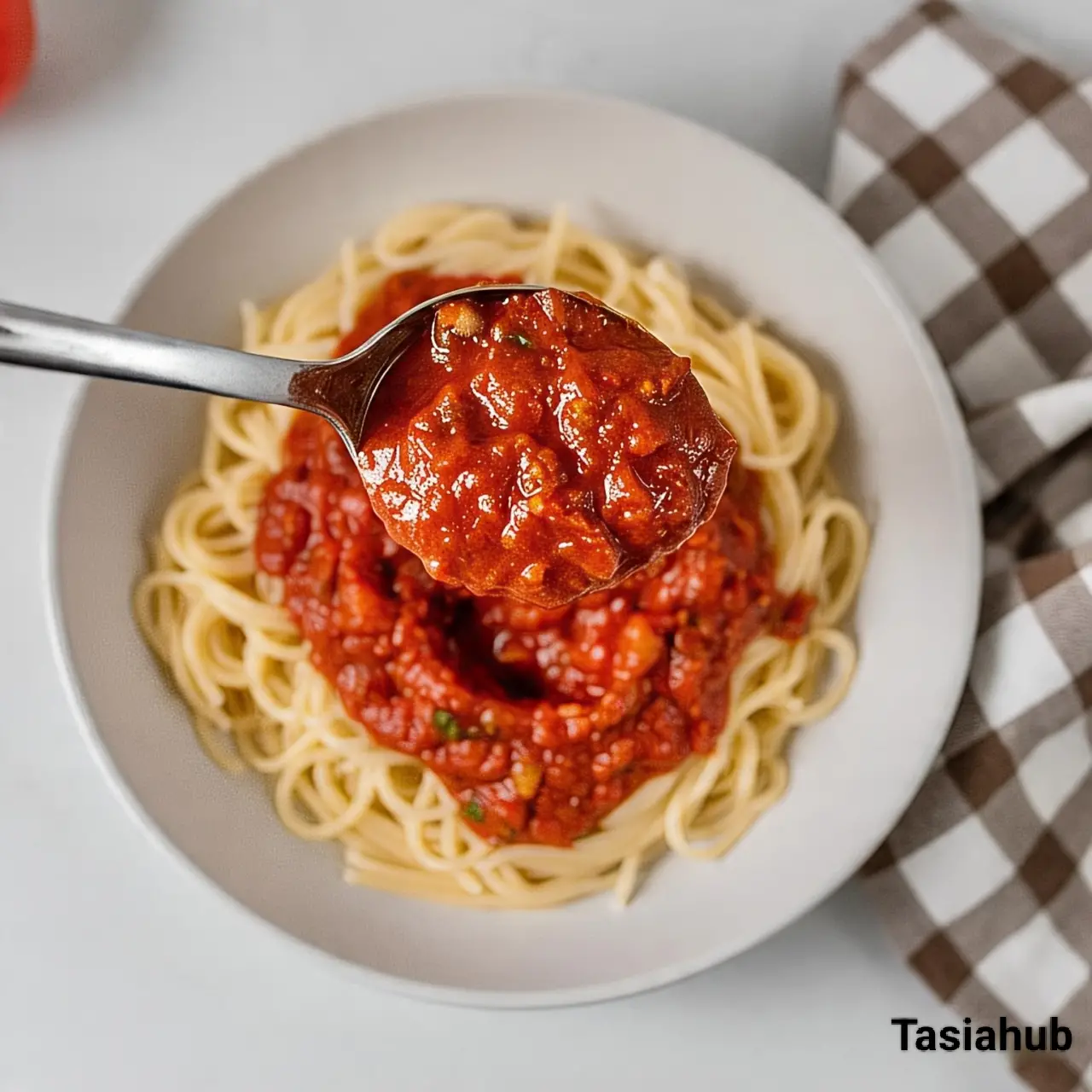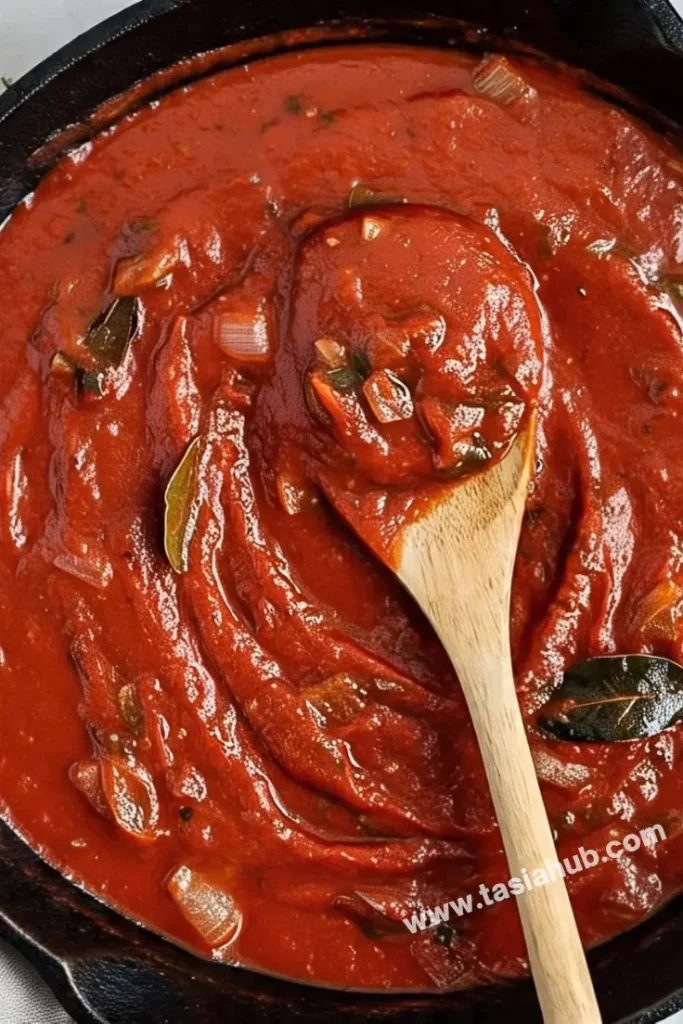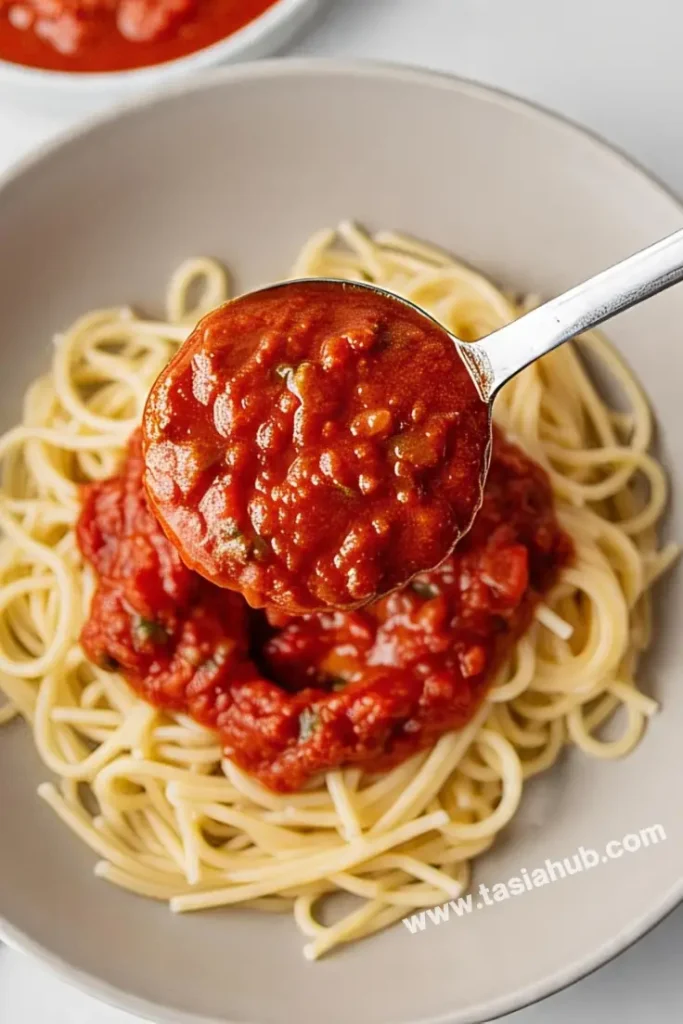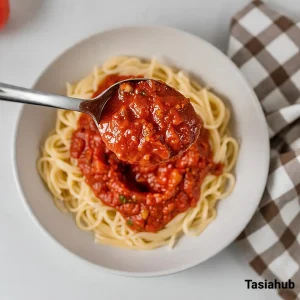Homemade Spaghetti Sauce

If there’s one thing that makes pasta night feel extra special, it’s a homemade spaghetti sauce that’s bursting with flavor. Forget the jars from the store — once you try making it yourself, you’ll never look back! This spaghetti sauce recipe is so simple, yet so delicious, you’ll wonder why you haven’t been making it all along. Whether you’re preparing a cozy meal for yourself or hosting a family dinner, this sauce will elevate your pasta to a whole new level.
What I love most about this spaghetti sauce is how versatile it is. You can customize it to your taste, adding herbs, spices, and extra ingredients depending on your cravings. But even if you keep it simple, the combination of fresh tomatoes, garlic, and a little olive oil creates a rich and flavorful base that’ll have everyone asking for seconds. It’s like giving your spaghetti the perfect blanket of goodness.
The best part? It doesn’t take hours to cook! In just under 30 minutes, you can whip up a sauce that tastes like it’s been simmering all day. And the aroma that fills your kitchen? Absolutely mouthwatering. So, next time you’re craving a comforting bowl of pasta, skip the pre-made sauce and give this one a try. Trust me, it’ll make your meal unforgettable.
Why You’ll Love It
- Fresh and Flavorful: Made with ripe, juicy tomatoes, fresh herbs, and garlic, this sauce is packed with natural flavors that jarred sauces just can’t compete with.
- Customizable: You can adjust the seasoning and ingredients to fit your tastes. Add extra garlic for a bolder flavor or toss in some red pepper flakes for a bit of heat — the choice is yours!
- Quick and Easy: Ready in under 30 minutes, this sauce is perfect for busy nights when you want a home-cooked meal without the long wait.
- Healthier Option: With no added preservatives or artificial ingredients, this homemade sauce is a healthier choice compared to store-bought alternatives.
- Perfect for Any Meal: Whether you’re serving it over spaghetti, lasagna, or using it as a dipping sauce for breadsticks, this versatile sauce works with almost any pasta dish or Italian-inspired meal.
Ingredient List
For the Sauce:
- 2 tbsp olive oil
- 1 medium onion, finely chopped
- 4 cloves garlic, minced
- 1 can (28 oz) crushed tomatoes
- 1 can (6 oz) tomato paste
- 1 cup water (or more, for desired thickness)
- 1 tsp sugar (optional, to balance acidity)
- Salt and pepper to taste
For the Herbs:
- 1 tsp dried basil
- 1 tsp dried oregano
- 1/2 tsp dried thyme
- 1 bay leaf
- A pinch of red pepper flakes (optional, for heat)
Ingredient Notes
- Olive Oil: I always use extra virgin olive oil for the best flavor. It really adds depth to the sauce.
- Garlic: Don’t skip the fresh garlic! It gives the sauce that authentic, aromatic kick that takes it to the next level.
- Crushed Tomatoes: Use high-quality crushed tomatoes — I prefer brands like San Marzano for their rich, sweet flavor.
- Tomato Paste: This helps thicken the sauce and intensifies the tomato flavor, so don’t skip it!
- Sugar: I add a teaspoon of sugar to balance out the acidity of the tomatoes, but you can skip it if you prefer a tangier sauce.
Kitchen Equipment Needed
- Large Skillet or Saucepan: A deep skillet works best for sautéing the onions and garlic and simmering the sauce evenly. I love using my cast-iron skillet because it retains heat beautifully and enhances the flavor.
- Wooden Spoon: Perfect for stirring the sauce, especially when you’re breaking down the tomato paste. It gives you that gentle control while avoiding scratches on your pan.
- Can Opener: You’ll need this to open the cans of tomatoes and paste — I prefer a manual can opener for its ease and reliability.
- Measuring Spoons: To ensure accurate seasoning and get the right balance of herbs and spices.
- Lid for the Pan: If you want to simmer the sauce on low heat, a lid will help trap moisture and prevent it from drying out.
Instructions
Step 1: Sauté the Onion and Garlic
- Place your skillet or saucepan over medium heat and add 2 tablespoons of olive oil. Let it warm up for about 1 minute.
- Add the finely chopped onion and sauté, stirring occasionally, until it becomes soft and translucent (about 3-5 minutes).
- Once the onion is ready, add the minced garlic and cook for an additional 1-2 minutes, stirring frequently. Be careful not to burn the garlic — you just want it fragrant.
Pro Tip: Keep an eye on the garlic! It burns quickly and can make your sauce taste bitter. Stir constantly once the garlic is in the pan.
Step 2: Combine the Tomatoes and Tomato Paste
- Pour in the can of crushed tomatoes and stir to combine with the onions and garlic.
- Add the tomato paste and stir until it’s fully incorporated into the sauce.
Pro Tip: Tomato paste is thick and sticky, so make sure to stir it well so it doesn’t clump. It’ll help thicken your sauce later.
Step 3: Simmer the Sauce
- Pour in about 1 cup of water to thin the sauce to your desired consistency. If you prefer a thicker sauce, you can add less water.
- Stir in the sugar (if using), dried basil, oregano, thyme, bay leaf, and a pinch of red pepper flakes (if you like heat). Season with salt and pepper to taste.
- Lower the heat and cover the pan, allowing the sauce to simmer for 20-25 minutes. Stir occasionally.
Pro Tip: If the sauce thickens too much during simmering, you can add a little more water to keep it at the consistency you like.
Step 4: Taste and Adjust
- After simmering, give the sauce a taste. Add more salt, pepper, or herbs if you feel it needs a little extra kick. You can also add a pinch more sugar if it’s too tangy.
- Don’t forget to take out the bay leaf before serving — it’s there for flavor but not meant to be eaten.
Pro Tip: Taste the sauce before serving to ensure the flavor is balanced. The right amount of seasoning makes all the difference!
Step 5: Serve and Enjoy
- Spoon the sauce over cooked spaghetti (or any pasta of your choice). Add some fresh grated Parmesan cheese on top, if desired.
- For an extra touch, sprinkle some fresh basil or parsley on top before serving.
Pro Tip: If you’re making this ahead of time, the flavors will continue to develop as it cools. Reheat gently on low heat when ready to serve.

Tips and Tricks for Success
- Don’t Overcook the Garlic: Garlic can turn bitter if cooked too long. Add it after the onions have softened, and stir constantly for that perfect aromatic flavor.
- Simmer Slowly: Let the sauce simmer on low heat to allow the flavors to develop. The longer it simmers, the more depth the sauce will have.
- Make It Ahead of Time: This sauce gets even better the next day! If you have time, make it ahead and let it sit in the fridge overnight to allow all the flavors to meld together.
- Adjust Consistency to Your Liking: If the sauce is too thick, just add a little more water or even some vegetable broth. If it’s too thin, let it simmer uncovered to thicken.
- Use a Non-Stick Pan: A non-stick pan makes stirring and clean-up easier, especially if you’re making a large batch.
Ingredient Substitutions and Variations
- Fresh Tomatoes: If you have fresh tomatoes on hand, you can use about 6-8 medium tomatoes. Just chop them up and cook them down with a little extra time to break down into a sauce.
- Olive Oil: You can substitute olive oil with butter for a richer, creamier sauce.
- Herb Variations: Feel free to swap out the dried herbs for fresh ones. Use 1 tablespoon of fresh basil, oregano, or thyme in place of the dried versions.
- Add Vegetables: For a heartier sauce, you can toss in finely chopped carrots, celery, or bell peppers during the sauté stage with the onions and garlic.
- Meat Lovers: Add cooked ground beef, turkey, or sausage for a meat sauce. Just brown the meat before adding the onions and garlic.
- Spicy Kick: Increase the red pepper flakes or add a chopped fresh chili to give your sauce some heat. You can also use hot paprika for a smoky, spicy twist.
Serving Suggestions
- Classic Spaghetti: Of course, serve this delicious sauce over classic spaghetti noodles for a timeless, comforting meal.
- Garlic Bread and Salad: I love serving this pasta with garlic bread and a crisp green salad — it balances the richness perfectly!
- Pasta Bake: Turn this sauce into a baked pasta dish! Layer the sauce with cooked penne or rigatoni, top with mozzarella, and bake until bubbly and golden.
- Meatballs on the Side: Serve with homemade or store-bought meatballs for a traditional Italian meal. The sauce is perfect for dipping or mixing with the meatballs.
- Zucchini Noodles: For a lighter twist, try serving this sauce over zucchini noodles (zoodles) for a low-carb option that still delivers on flavor.

Storage and Reheating Instructions
- Store in an Airtight Container: Let the sauce cool completely, then transfer it to an airtight container. It will stay fresh in the fridge for up to 4-5 days.
- Freeze for Later: This sauce freezes well! Simply transfer it to a freezer-safe container or a ziplock bag and freeze for up to 3 months. Make sure to leave room for expansion when freezing.
- Reheat on the Stove: To reheat, place the sauce in a saucepan over medium heat. Stir occasionally and add a splash of water if it’s too thick.
- Microwave Option: If you’re in a rush, you can microwave the sauce in a microwave-safe bowl. Heat it in 30-second intervals, stirring between each, until it’s heated through.
Frequently Asked Questions
How long does this spaghetti sauce take to make?
This spaghetti sauce takes about 30 minutes from start to finish, making it a quick and easy weeknight dinner option.
Can I make this sauce ahead of time?
Absolutely! The sauce actually tastes even better the next day as the flavors continue to develop. Just store it in an airtight container in the fridge for up to 5 days.
Can I freeze this spaghetti sauce?
Yes! This sauce freezes wonderfully. You can store it in a freezer-safe container or a ziplock bag for up to 3 months. Just thaw and reheat when you’re ready to enjoy it.
What can I serve with this spaghetti sauce?
While it’s perfect over pasta, you can also use it for pasta bakes, meatball subs, or even as a pizza sauce. It’s super versatile!
Can I adjust the spice level?
Definitely! If you like a spicier sauce, add more red pepper flakes or even some chopped fresh chili. If you prefer a milder sauce, simply leave out the heat.
Can I use fresh tomatoes instead of canned?
Yes, fresh tomatoes work great! Use about 6-8 medium tomatoes, chop them up, and cook them down until they break apart into a sauce.
Did you try this recipe? Let me know in the comments how it turned out!
Don’t forget to share your photos on Instagram and tag me (@tasiahub_) or use the hashtag (#tasiahub). I’d love to see your creations!

Homemade Spaghetti Sauce
Equipment
- Large Skillet or Saucepan
- Wooden spoon
- Can Opener
- Measuring spoons
- Lid for the Pan
Ingredients
For the Sauce:
- 2 tbsp olive oil
- 1 medium onion finely chopped
- 4 cloves garlic minced
- 1 can 28 oz crushed tomatoes
- 1 can 6 oz tomato paste
- 1 cup water or more, for desired thickness
- 1 tsp sugar optional, to balance acidity
- Salt and pepper to taste
For the Herbs:
- 1 tsp dried basil
- 1 tsp dried oregano
- 1/2 tsp dried thyme
- 1 bay leaf
- A pinch of red pepper flakes optional, for heat
Instructions
Step 1: Sauté the Onion and Garlic
- Place your skillet or saucepan over medium heat and add 2 tablespoons of olive oil. Let it warm up for about 1 minute.
- Add the finely chopped onion and sauté, stirring occasionally, until it becomes soft and translucent (about 3-5 minutes).
- Once the onion is ready, add the minced garlic and cook for an additional 1-2 minutes, stirring frequently. Be careful not to burn the garlic — you just want it fragrant.
- Pro Tip: Keep an eye on the garlic! It burns quickly and can make your sauce taste bitter. Stir constantly once the garlic is in the pan.
Step 2: Combine the Tomatoes and Tomato Paste
- Pour in the can of crushed tomatoes and stir to combine with the onions and garlic.
- Add the tomato paste and stir until it’s fully incorporated into the sauce.
- Pro Tip: Tomato paste is thick and sticky, so make sure to stir it well so it doesn’t clump. It’ll help thicken your sauce later.
Step 3: Simmer the Sauce
- Pour in about 1 cup of water to thin the sauce to your desired consistency. If you prefer a thicker sauce, you can add less water.
- Stir in the sugar (if using), dried basil, oregano, thyme, bay leaf, and a pinch of red pepper flakes (if you like heat). Season with salt and pepper to taste.
- Lower the heat and cover the pan, allowing the sauce to simmer for 20-25 minutes. Stir occasionally.
- Pro Tip: If the sauce thickens too much during simmering, you can add a little more water to keep it at the consistency you like.
Step 4: Taste and Adjust
- After simmering, give the sauce a taste. Add more salt, pepper, or herbs if you feel it needs a little extra kick. You can also add a pinch more sugar if it’s too tangy.
- Don’t forget to take out the bay leaf before serving — it’s there for flavor but not meant to be eaten.
- Pro Tip: Taste the sauce before serving to ensure the flavor is balanced. The right amount of seasoning makes all the difference!
Step 5: Serve and Enjoy
- Spoon the sauce over cooked spaghetti (or any pasta of your choice). Add some fresh grated Parmesan cheese on top, if desired.
- For an extra touch, sprinkle some fresh basil or parsley on top before serving.
Notes
Nutritional Value (Per Serving)
- Calories: 90–110 kcal
- Protein: 2–3g
- Carbohydrates: 12–15g
- Sugars: 5–7g
- Fat: 4–6g
- Saturated Fat: 0.5–1g
- Fiber: 2–3g
- Sodium: 350–450mg
The nutritional information provided on this website is an estimate only and is intended for general guidance. We cannot guarantee its accuracy and recommend consulting a qualified healthcare professional or registered dietitian for personalized nutrition advice.